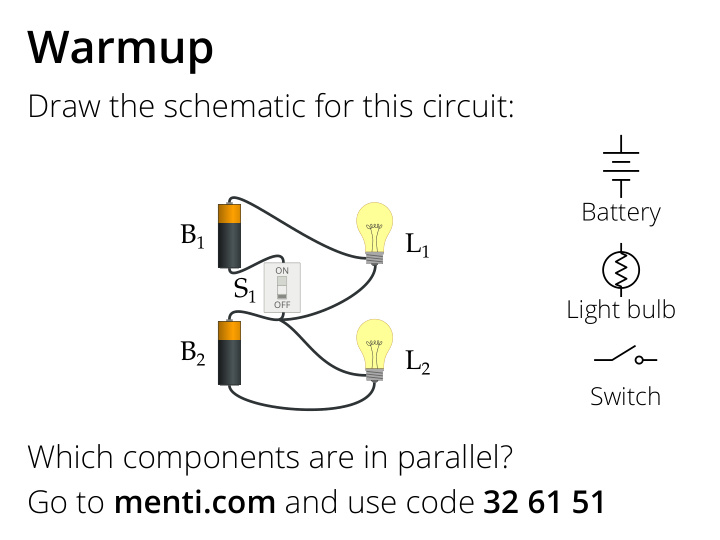



Warmup Draw the schematic for this circuit: Battery B 1 L 1 ON S 1 Light bulb OFF B 2 L 2 Switch Which components are in parallel? Go to menti.com and use code 32 61 51
ENGR 40M, Lecture 2: KVL, KCL, Ohm's law, and power Steven Bell 28 June 2017
Logistics Fill out the lab section signup by Friday Lab 1 will be posted online tomorrow Sign up on Piazza! Go to a soldering lab, if you haven't already
Objectives By the end of class, you should be able to: Explain Kircho ff 's Voltage Law and Kircho ff 's Current Law qualitatively and mathematically. Given a circuit of block elements with known voltages and/ or currents, determine the unknown voltages and currents using KVL/KCL. Use Ohm's law with KVL/KCL to fi nd unknown voltages and currents. Calculate the power supplied or dissipated by a device.
Labeling current 3 marbles/sec -3 marbles/sec quercettistore.com
Labeling current 2A 3 marbles/sec 2A -2A -3 marbles/sec Labels alone do not indicate direction. You must also consider the sign! quercettistore.com
Labeling voltage (top) (bottom) 2.4 cm -2.4 cm (bottom) (top) quercettistore.com
Labeling voltage (top) (bottom) 2.4 cm -2.4 cm (bottom) (top) (top) (bottom) 5V -5V 5V (bottom) (top) quercettistore.com
What is the voltage V 1 and the current i 1 ? 0.2 A 1.5 V V 1 i 1 Go to menti.com and use code 32 61 51
Kircho ff 's Current Law Current that goes in must come out. It can't pile up anywhere or just disappear. 5 marbles 3 marbles 2 marbles
Kircho ff 's Current Law The sum of currents going into a node is zero. i 2 i 1 i 3
Write all the KCL equations you can: i 3 i 1 i 4 i 5 i 2 i 6
Kircho ff 's Voltage Law If you go around a complete loop, the total height must be zero (because you're back where you started).
Kircho ff 's Voltage Law The sum of voltages around any loop is zero. v 2 v 1 v 3 The only tricky part is being consistent with the signs.
Write all the KVL equations you can: v 3 v 4 v 5 v 1 v 2 v 7 v 6
Find the voltage V 2 and current i 2 : 50 mA i 2 v 2 3V 120 mA Find the voltage V 2 and current i 2 Challenge question: is the gray element absorbing or supplying electrical energy?
Which bulb lights up first? A B A B OFF ON When the switch is closed (turned on): A) the one on the le � lights up first. B) the one on the right lights up first. C) both light up at exactly the same time. D) this is a trick question; neither bulb lights up.
Why does the light bulb light up? The filament gets hot and glows because: A) the current is used up in the light bulb, becoming heat. B) the voltage accelerates electrons and they collide with the metal, losing their energy as heat. C) charges pile up inside the filament, and the repulsion of their electric fields creates heat. D) this is a trick question; the light bulb doesn't light up.
Collecting energy from marbles What determines how much energy I get?
Joules I = Coloumbs V = second Coloumb Joules Coloumbs Joules V ⋅ I = = second second Coloumb Joules/sec is called a Watt , abbreviated W . How much power does a light bulb use, if it is connected to 120V and draws 0.5 A?
A more exciting example
How much power does the source absorb? -0.5A 120V
Let's make a deal When calculating power, current references should match voltage references: ✔ ✔ ✗ ✗ Then positive power is always power absorbed, and negative power is always power supplied. This is called the "passive sign convention" .
Which of these are absorbing electrical power ? Watch the signs! 1A 2V -1A 2V -1A 2V A B C 1A -2V 1A 2V -1A -2V D E F
Device models
Marble-track resistor woodgears.ca
Ohm's Law For a resistor (and only a resistor): I = V R R is the resistance, measured in Ohms Represented with the schematic symbol:
What is the current i ? i 5V 1k Ω Challenge: what would happen to the current if we added a second 1k Ω resistor in parallel?
How do you feel about this material?
Recommend
More recommend